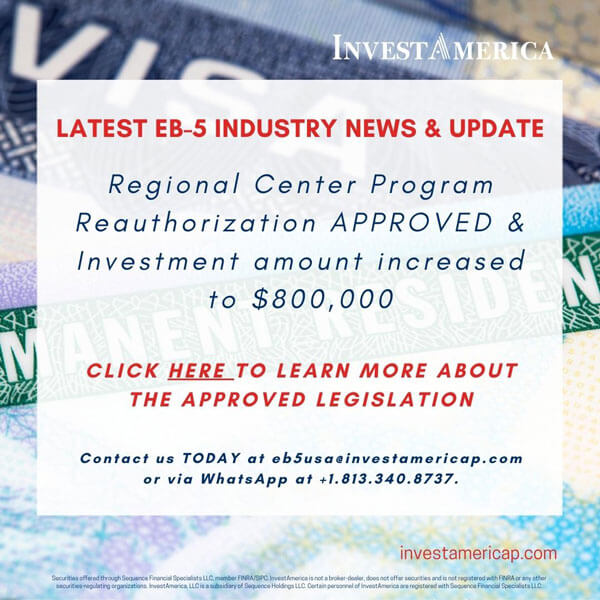EB-5 Green Card
EB-5 Green Card Program
About the EB-5 Green Card Investor Program
The EB-5 Immigrant Investor Program, established by Congress in 1990 and overseen by the United States Citizenship and Immigration Services (USCIS), offers a pathway to obtaining a green card, also known as a permanent resident visa, for foreign nationals and their families. To qualify, individuals need to invest a minimum of $800,000 in a new U.S. business that either creates or preserves at least 10 new U.S. jobs. This investment allows the main applicant, their spouse, and unmarried children under the age of 21 to secure an EB-5 green card.
In 1992, Congress introduced the Regional Center Program, an extension of the EB-5 visa initiative. This program enables investors to put their money into a new U.S. business affiliated with a USCIS-approved Regional Center. Each year, regulations permit the State Department to issue 10,000 EB-5 visas under this category.
Once an investor’s I-526 petition is approved by the USCIS, they receive a two-year conditional EB-5 green card. Subsequently, the investor must file a Form I-829 petition within 21 to 24 months of I-526 approval. This petition serves to demonstrate that the investor maintained the $800,000 investment at risk for the two-year period and that the U.S. investment created the required minimum of 10 jobs.
Upon approval of the I-829 petition, the investor becomes eligible for the return of their capital, contingent upon the success of the EB-5 Project.

EB-5 investors are required to invest in a new commercial enterprise, defined as a for-profit activity formed for lawful business conduct. The commercial enterprise must meet specific criteria, as outlined below:
Establishment Date: The enterprise must have been established after November 29, 1990. Alternatively, if it was established on or before this date, it can still qualify if:
- It was purchased and restructured or reorganized in a way that results in a new commercial enterprise, or
- It was expanded through the investment, leading to a 40-percent increase in net worth or employees.
Forms of Business: The commercial enterprise can take various forms, including but not limited to:
- Sole proprietorship
- Partnership (limited or general)
- Holding company
- Joint venture
- Corporation
- Business trust or any other entity, whether publicly or privately owned.
It’s important to note that this definition encompasses a commercial enterprise comprising a holding company and its wholly owned subsidiaries. However, each subsidiary must engage in a for-profit activity formed for lawful business operations.
Exclusion: Non-commercial activities such as owning and operating a personal residence are not considered within this definition.
Job Creation and Capital Investment Requirements
To qualify for the EB-5 Immigrant Investor Program, applicants must adhere to specific job creation and capital investment requirements. Here’s a breakdown of these essential criteria:
Job Creation Requirements:
Investors are obligated to create or preserve a minimum of 10 full-time jobs for eligible U.S. workers within two years of their admission to the United States as Conditional Permanent Residents.
In the EB-5 Immigrant Investor Program, regional center investments offer a unique advantage in job creation calculations versus the direct investment model. Regional centers utilize specialized economic models, commonly employed by the Department of Labor and other government agencies, to model outcomes related to not only direct jobs within the invested project but also indirect jobs in businesses that supply goods or services, as well as induced jobs generated by spending in the community. This comprehensive approach to job counting allows regional center investors to leverage a broader scope of job creation, encompassing direct, indirect, and induced employment opportunities. This flexibility in job calculation often makes regional center investments a favorable choice for EB-5 investors concerned about job creation and tracking when compared to the direct investment model. For the most current and detailed information, it’s advisable to refer to the official USCIS policy manual or consult immigration professionals well-versed in the EB-5 program.
Job creation can be either direct or indirect:
– Direct Jobs: These are identifiable positions for qualified employees within the enterprise where the investor has directly invested capital.
– Indirect Jobs: Indirect jobs are those created as a result of capital investment in a commercial enterprise that are calculated using economic models. This option is available to EB-5 investments that are associated with a regional center.
It’s important to note that investors can only be credited with preserving jobs in a troubled business, which is an enterprise existing for at least two years and has incurred a net loss during the 12- or 24-month period preceding the priority date on the investor’s Form I-526. A qualified employee, in this context, refers to a U.S. citizen, permanent resident, or other immigrant authorized to work in the United States.
Capital Investment Requirements:
Investment capital, comprising cash, equipment, inventory, tangible property, cash equivalents, and indebtedness secured by assets owned by the investor, must be valued at fair-market value in U.S. dollars. Borrowed capital cannot be utilized for this purpose, and assets acquired through unlawful means are not considered valid capital.
The minimum qualifying investment for the EB-5 program is $1,050,000 million in the United States. However, if the investment is made within a Targeted Employment Area (TEA) — an area with high unemployment or rural designation — the minimum investment requirement is reduced to $800,000. A TEA is defined as a rural area or an area experiencing unemployment of at least 150 percent of the national average rate at the time of investment.
Adhering to these job creation and capital investment guidelines ensures that EB-5 investors contribute significantly to the U.S. economy while securing their path to permanent residency in the United States.

